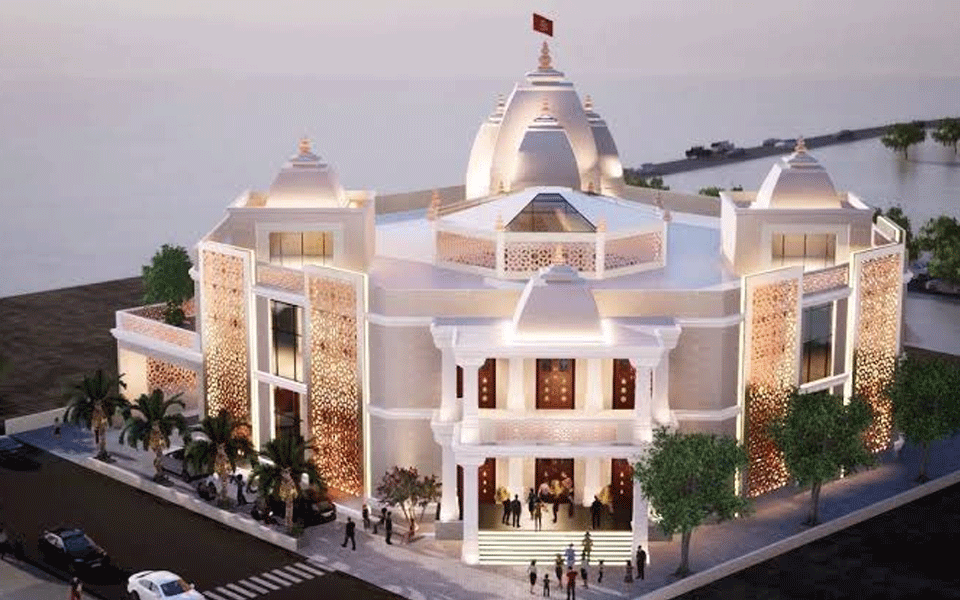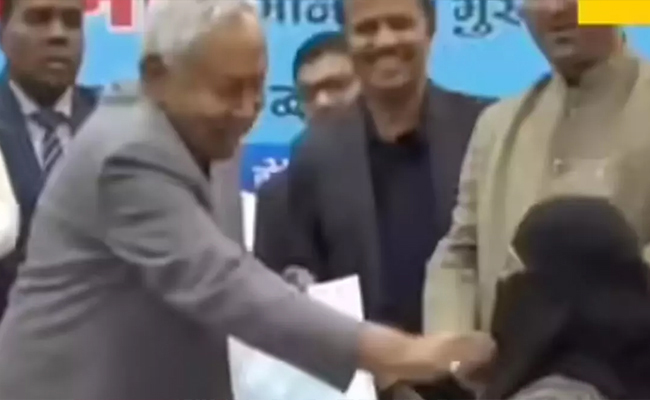Dubai(PTI):: A majestic new Hindu temple that blends Indian and Arabic architectural designs has been inaugurated here in Jebel Ali Village, with a powerful message of tolerance, peace and harmony.
Located in a neighbourhood referred to as the emirate's 'worship village', the temple formally opened its doors to worshippers across the UAE on Tuesday.
"Sheikh Nahyan bin Mubarak Al Nahyan, Minister of Tolerance & Coexistence & Amb @sunjaysudhir inaugurated the new Hindu Temple in Dubai. On the occasion, Ambassador Sunjay Sudhir thanked the UAE Government for their support to the 3.5 million-strong Indian diaspora in the UAE," the Indian Embassy in Abu Dhabi tweeted.
A powerful message of tolerance, peace and harmony, bringing together people from various faiths, marked the official opening ceremony, the Khaleej Times newspaper reported.
Priests chanted Om Shanti Shanti Om in a peace salutation and musicians playing the tabla and dhol Indian drums greeted people as they entered.
The 'worship village' in Jebel Ali now houses nine religious shrines, including seven churches, the Guru Nanak Darbar Sikh Gurudwara, and the new Hindu house of worship.
A ribbon-cutting ceremony was organised in the main prayer hall.
Sheikh Nahyan was joined by Ambassador Sudhir, CEO of the social regulatory and licensing agency for the Community Development Authority (CDA), Dr Omar Al Muthanna and trustee of the Hindu Temple Dubai, Raju Shroff.
Ahmed Abdul Karim Julfar, director-general of the Community Development Authority, was also present at the event.
Over 200 dignitaries, including the heads of diplomatic missions, religious leaders of several faiths, business owners and Indian community members were also present at the glittering opening ceremony.
Sudhir said: "It is welcome news for the Indian community that a new Hindu temple is being inaugurated in Dubai today. The temple's opening serves the religious aspirations of the large Hindu community living in the UAE.
"The new temple is adjoining a Gurudwara, which was opened in 2012. We are honoured that Sheikh Nahayan inaugurated the new Hindu temple in Dubai. We thank the graciousness and generosity of the Dubai Government for providing land for the temple and facilitating its construction," the Indian envoy said.
Plans to construct the 70,000-square-foot house of worship were announced in 2020, shortly after the Covid-19 pandemic struck the city.
The temple features detailed hand carvings, ornate pillars, brass spires and striking lattice screens that blend Indian and Arabic architecture.
Speaking to Khaleej Times on the sidelines of the opening ceremony, Shroff said: "The temple opening in Dubai is a dream come true not just for Hindus, but for Indians all over the UAE. The temple is a true representation of how we perceive religion bringing cultures together."
"Despite COVID-19, construction timelines were not hampered because of the support of the Dubai government. The Hindu Temple Dubai is truly a remarkable icon of how receptive and compassionate Dubai and the Government of the UAE are. Whether it was in 1958 to launch the first 'temple' in the country to the Hindu temple now, the Emirati generosity remains."
Pre-registration is required to visit the temple and devotees can register online before arrival.
By the end of the year, there will be a spacious community centre where Hindu ceremonies, rituals and prayers can take place, including weddings.
Let the Truth be known. If you read VB and like VB, please be a VB Supporter and Help us deliver the Truth to one and all.
New Delhi (PTI): The BJP on Wednesday accused the Congress of running misleading propaganda over the trial court's decision in the National Herald case and said the court refused to take cognisance of the complaint but did not set aside the case.
The case is still pending trial in the Delhi High Court, and the trial court in its order on Tuesday said that the Enforcement Directorate (ED) can continue its investigation, BJP national spokesperson Gaurav Bhatia asserted.
"The court yesterday (Tuesday) said that since it is a private complaint and no FIR has been lodged, it will not take cognizance of it. It's a technical matter. The court also said that ED can continue its investigation further. The court did not set it aside," Bhatia told a press conference at the BJP headquarters here
"Its trial is still going on. Sonia Gandhi is still Accused Number-1 and Rahul Gandhi Accused Number-2," the BJP spokesperson said, alleging, "The Gandhi family thrives on deceit, deception, and propaganda."





